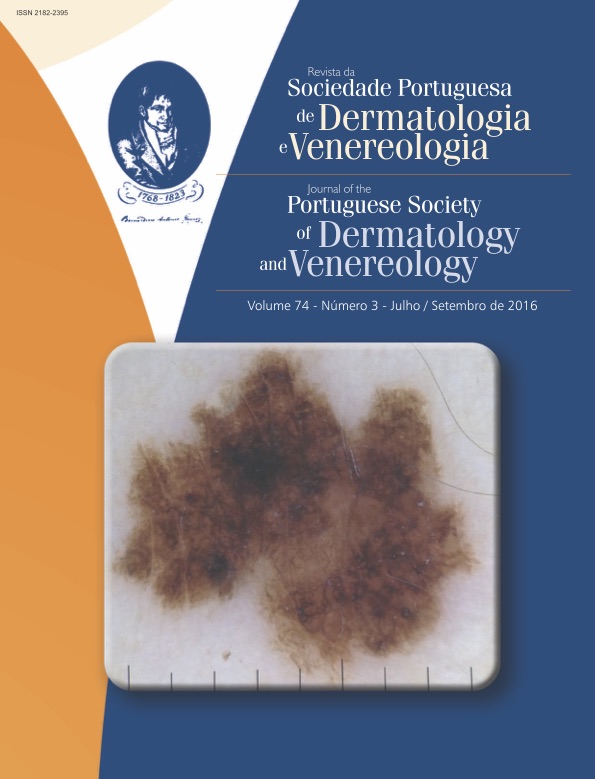Sentinel Lymph Node Biopsy in Thick Melanoma: A Single-Centre Retrospective Clinical Study
Abstract
Background: Sentinel lymph node biopsy is widely accepted in the staging of melanoma. The prognostic value of this technique seems to be greater in intermediate-thickness melanoma (1-4 mm) than in thick melanoma (>4 mm).
Objective: To assess the prognostic value of sentinel node status in patients with thick melanoma.
Patients and Methods: The disease-free survival and the overall survival were estimated using Kaplan-Meier curves and a Cox regression model in a sample of patients with thick melanoma.
Results: Forty-three patients were included (52.2% male) with a mean age of 63.9 years. Sentinel node biopsy was positive in 20 patients (46.5%). Mean follow-up was 40 months. Patients without sentinel node metastases had a 5-year disease-free survival rate significantly higher than those with positive sentinel node (63% versus 19%, p < 0.05). The 5-year overall survival rate was tendentiously lower in patients with positive sentinel node (52% versus 79%), lacking statistical significance.
Conclusion: The sentinel node status was not able to predict the overall survival in our series of thick melanomas, probably due to the high risk of hematic spread. However, sentinel lymph node biopsy provided important prognostic information, since the sentinel lymph node status influenced the disease-free survival.
Downloads
References
Morton DL, Cochrane AJ, Thompson JF, Elashoff R, Essner R, Glass EC, et al. Sentinel lymph node for early
node biopsy for early stage melanoma: accuracy and morbidity in MSLT-1, an international multi-centre trial.
Ann Surg. 2005; 242:302-11.
Morton DL, Thompson JF, Cochran AJ, Mozzillo N, Nieweg OE, Roses DF, et al. Final Trial Report of Sentinel-
Node Biopsy versus Nodal Observation in Melanoma. N Engl J Med. 2014; 370:599-609.
Fairbairn NG, Orfaniotis G, Butterworth M. Sentinel lymph node biopsy in thick malignant melanoma: a
-year single unit experience. J Plast Reconstr Aesthet Surg. 2012; 65:1396-402.
Hinz T, Ahmadzadehfar H, Wierzbicki A, Hoeller T, Wenzel J Biersack HJ, et al. Sentinel lymph node status as
most important prognostic factor in patients with high-risk cutaneous melanomas (tumour thickness >4mm):
outcome analysis from a single institution. Eur J Nucl Med Mol Imaging. 2012; 39:1316-25.
Rughani MG, Swan MC, Adams TS, Marshall A, Asher R, Cassel OC, et al. Sentinel lymph node status predicts
survival in thick melanomas: the Oxford perspective. Eur J Surg Oncol. 2012; 38:936-42.
Kelly J, Redmond HP. The role of sentinel lymph node biopsy in patients with thick melanoma. A single centre
experience. Surgeon. 2012; 10:65-70.
Göppner D, Ulrich J, Pokrywka A, Peters B, Gollnick H, Leverkus M. Sentinel lymph node biopsy status is a key parameter to stratify the prognostic heterogeneity of malignant melanoma in high-risk tumors >4 mm. Dermatology. 2011; 222:59-66.
Covarelli P, Vedovati MC, Becattini C, Rodelli F, Tomassini GM, Messina S, et al. The sentinel node biopsy in
patients with thick melanoma: outcome analysis from single-institution database. In Vivo. 2011; 25:439-43.
Scoggins CR, Bowen AL, Mertin RC, Edwards MJ, Reintgen DS, Ross MI, et al. Prognostic information from
sentinel lymph node biopsy in patients with thick melanoma. Arch Surg. 2010; 145: 622-7.
Gajdos C, Griffith KA, Wong SL, Johnson TM, Chang AE, Cimmino VM, et al. Is there a benefit to sentinel
lymph node biopsy in patients with T4 melanoma? Cancer. 2009; 115: 5752-60.
Gutzmer R, Satzger I, Thoms KM, Völker B, Mitteldorf C, Kapp A, et al. Sentinel lymph node status is the most important prognostic factor for thick melanoma (> or = 4mm) melanomas. J Dtsch Dermatol Ges. 2008;
:198-203.
Cecchi R, Buralli L, Innocenti S, Seghieri G, De Gaudio C. Sentinel lymph node biopsy in patients with thick
(= 4mm) melanoma: a single-centre experience. J Eur Acad Dermatol Venereol. 2007; 21:758-61.
Vermeeren L, van der Ent FW, Sastrowijoto PS, Hulsewé KW. Thick melanoma: prognostic value of positive sentinel nodes. World J Surg. 2009; 33: 2464-8.
Rhodes AR. Prognostic usefulness of sentinel lymph node biopsy for patients who have clinically node negative, localized, primary invasive cutaneous melanoma: a Bayesian analysis using informative published
reports. Arch Dermatol.2011; 147:408-15.
Oliveira Filho RS, Silva AL, Oliveira DA, Oliveira GG, Nahas FX. Sentinel node biopsy should not be recommended for patients with thick melanoma. Rev Col Bras Cir. 2013; 40:127-9.
Rondelli F, Vedovati MC, Becattini C, Tomassini GM, Messina S, Noya G, et al. Prognostic role of sentinel
node biopsy in patients with thick melanoma: a meta-analysis. J Eur Acad Dermatol Venereol. 2012;
:560-5.
All articles in this journal are Open Access under the Creative Commons Attribution-NonCommercial 4.0 International License (CC BY-NC 4.0).








